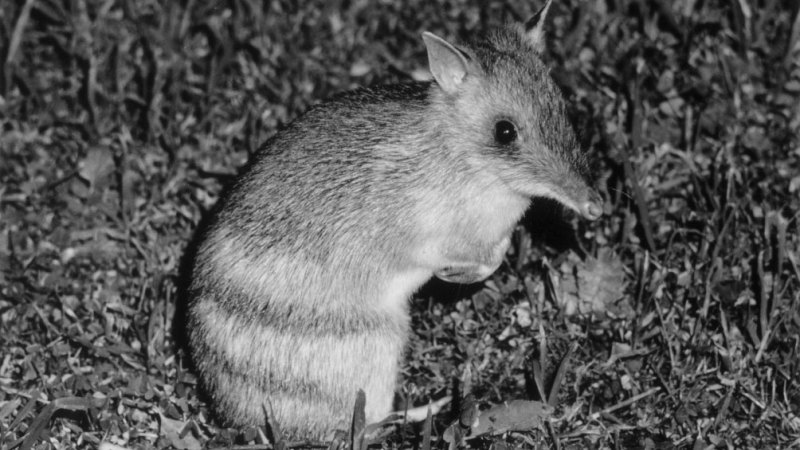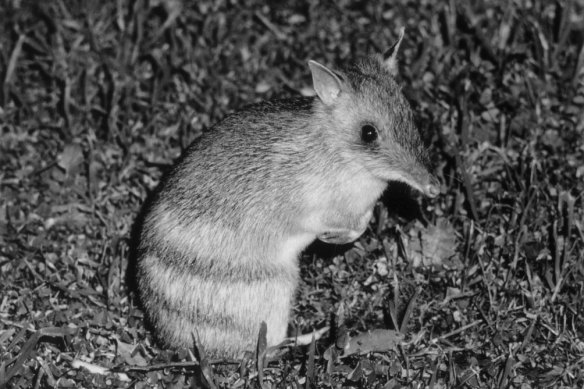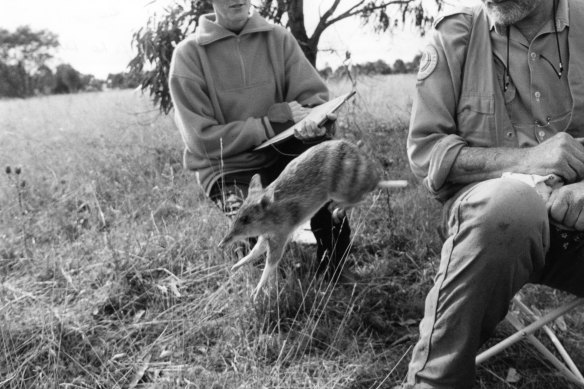Save articles for later
Add articles to your saved list and come back to them any time.
First published in The Age on April 28, 1993
The bandicoot leaps back from the brink
Science and a year of record rains have led to Victoria’s rarest mammal, the eastern barred bandicoot, making a dramatic leap back from the brink of extinction.
An Eastern Barred Bandicoot.Credit: P. R. Brown
At last count, more than 400 bandicoots were thriving and breeding in three protected locations in Victoria — at Gellibrand Hill, near Tullamarine airport, at Mooramong, a property owned by the Department of Conservation and Environment near Skipton, and in a reserve near Hamilton in western Victoria.
The population of the bandicoot, Perameles gunnil, once abundant in Victoria’s grasslands, was reduced to no more than a few dozen animals living in abandoned car bodies at Hamilton’s rubbish tip by the late 1980s.
The bandicoot’s decline was caused by massive habitat loss as land was cleared for farms, and the depredations of two aliens, the fox and feral cat.
But now a captive-breeding program, backed by first-class scientific research, has put the bandicoot back in business.
From a nucleus of a few animals brought in from the wild at Hamilton, the Zoological Trust of Victoria established a breeding colony, which has provided the bandicoots reintroduced at the three sites.
John Seebeck, and a volunteer, Samantha Greiner, with a bandicoot in bounding good health.Credit: Andrew De La Rue
A population geneticist at La Trobe University, Dr Neil Murray, has confirmed that despite its brush with extinction, the bandicoot remains in robust genetic health.
The project coordinator, Mr John Seebeck, a zoologist at the Arthur Rylah Research Institute in Heidelberg, says the original colony of 60 bandicoots established at Gellibrand Hill in 1991 has prospered.
With predators excluded by a high fence, the natural fecundity of the bandicoots has done the rest. Female bandicoots can begin breeding at three months and can produce four litters a year, with an average litter size of 2.5.
After the exceptional rains of last spring and early summer, a recent census counted 120 animals. Few carried the tags of the founding population, confirming that most had been born in the reserve.
The small population established on Mooramong is also expanding — despite the absence of protective fences. Cats and foxes were trapped or shot before the bandicoots were released, and Mr Seebeck says departmental officers remain vigilant.
Mr Seebeck says that last year Hamilton’s citizens persuaded the department, in the face of some scientific doubts, to release a small number of captive-bred animals back into a reserve near the town.
In a warming display of devotion for their waif species, Hamiltonians volunteered to patrol the reserve to keep cats and foxes under control. A census taken by Mr Seebeck indicates that the colony is thriving.
Most Viewed in National
From our partners
Source: Read Full Article




